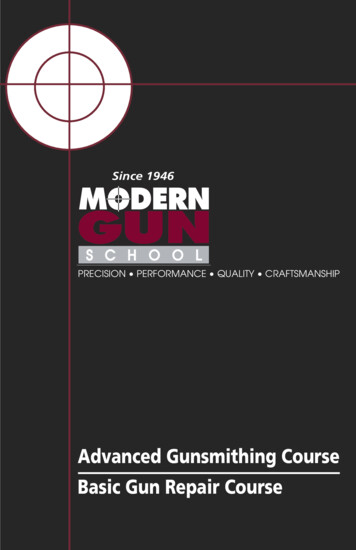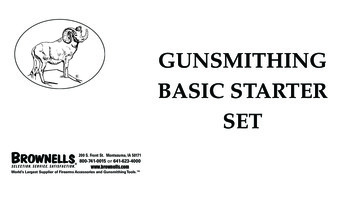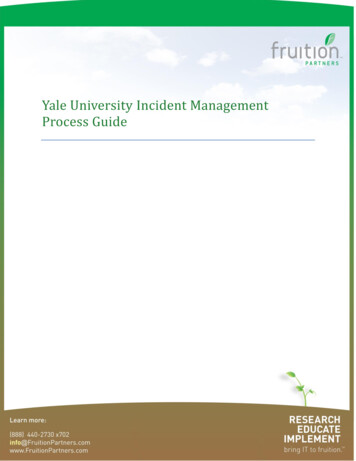
Transcription
GunsmithingPDF generated using the open source mwlib toolkit. See http://code.pediapress.com/ for more information.PDF generated at: Fri, 15 Aug 2014 18:08:54 UTC
ContentsArticlesGunsmith1John Browning10Jonathan Browning16Val A. Browning18John Garand20Dieudonné Saive22Eugene Stoner24Mikhail Kalashnikov26ReferencesArticle Sources and Contributors34Image Sources, Licenses and Contributors35Article LicensesLicense36
Gunsmith1GunsmithA gunsmith is a person who repairs, modifies, designs, or builds guns. This occupation differs from an armorer. Agunsmith does factory level repairs, renovation (such as applying metal finishes), and makes modifications andalterations for special uses. Gunsmiths may also apply carvings, engravings and other decorative features to anotherwise finished gun.Gun shop in Mons (Belgium).OverviewGunsmiths may be employed in: factories by firearms manufacturers, armories by military or law-enforcement agencies, sporting goods stores, or small gunsmith shops, as either the owner, or as one of a handful ofemployees.To pursue the entirety of this trade, a gunsmith must possess skills as aparts fabricator, a metalworker and/or blacksmith, a woodworker, and/or anartisan; be knowledgeable in shop mathematics, ballistics, chemistry, andmaterials engineering; be knowledgeable in the use and application of avariety of hand, power, and machinists tools and measuring devices; and becapable of working accurately and precisely. Those who are (self-)employed in small gunsmith shops must also possess skills as smallbusiness operators; work effectively with a wide variety of customers; andremain abreast of, and comply with federal, state, and local laws,ordinances, and requirements.A gunsmith at work, 1613Due to the great breadth of subject matter to be mastered, many gunsmiths specialize in only a few of the skillsrequired of the general gunsmith. Alternatively, some gunsmiths learn many of the skills of the trade, but only applythem to a few weapon types (e.g. only pistols, only shotguns, only specific brands or models).
GunsmithResponsibilitiesThe primary technical responsibility of gunsmiths is to ensure that the guns they work on function safely.They accomplish this firstly by always properly observing gun safety handling procedures: both in their own actions,and in the actions of their customers and the people around them.They accomplish this secondly by inspecting guns to ensure safe mechanical operation. Gunsmiths use their in-depthknowledge of guns to guide these inspections: either repairing deficiencies; or notifying customers of unsafeconditions and taking steps to prevent catastrophic failures.Some of the ways that even properly handled guns can fail and endanger their users and those around them are: Improper AssemblyMissing PartsCracks: all cracked parts are cause for concern, but especially so in the chamber-area, bolt, bolt-lugs, or buttstock.Bore Obstructions: being either dented or bent barrels, or foreign material in barrels.Improper Headspace: dimensions concerning the relative locations of the chamber and the bolt are not withinspecified tolerances. Improper Timing: (applies to fully automatic firearms and revolvers). Safety-Mechanism Malfunctions: potentially allowing a gun with the safety mechanism supposedly engaged tounexpectedly fire. Worn Sear Edges: potentially allowing a firearm to unexpectedly fire when the safety mechanism is disengaged. Firing-Pin Tips Deformed: leading to the possibility of primer-rupture.This list is not comprehensive. Many failure modes are dependent on the particular model of firearm.Common Tasks(listed in approximate, but not exact, order of increasing difficulty) Disassemble, clean, inspect, lubricate & reassemble.Remove corrosion and touch-up finish.Repair burred or damaged parts with files & stones.Replace defective parts with factory-made replacements, hand-fitting as necessary.Add after-market customizations: sling-swivels recoil-pads iron-sights scopes grip caps butt platesRepair and re-finish wooden stock parts.Checker or re-checker grip areas.Deepen or clean up worn or damaged engravings & markings.Re-crown damaged muzzles on a lathe.Repair dented shotgun barrels.Install (solder) or repair rib on shotgun barrels, or repair double-barrel assemblies.Measure & correct head-space dimensions.Check for excessive bore erosion. Troubleshoot and repair feeding, ejecting & firing problems. Test-fire guns with conventional loads to ensure proper operation. Fabricate wooden stocks to customer specifications and body dimensions. Fit same to existing receiver and barrel.2
Gunsmith Glass-bed actions to stocks to improve accuracy.Remove existing metal finish, and re-blue metal parts.Fabricate replacement parts from metal stock.Modify trigger-pull weight through careful stoning of trigger mechanism parts.Fire proof-loads through weapons to insure sufficient strength of parts under over-load conditions.Replace worn barrels, which have fired so many rounds that they are no longer of the specified caliber (whichleads to loss of accuracy).Change caliber or cartridge of existing rifle, by changing barrel, and modifying receiver.Re-cut rifling and change caliber of existing barrel.Design and build complete rifles by fitting stock barrels to stock receivers; fabricating or purchasing additionalparts as needed, and fitting same to rifle. Fitting custom stock to same.Design and build a complete rifle starting with several pieces of blank steel and a slab of walnut; using nothingmore than a lathe, saws, files, chisels, & rasps.SpecializationsWhile some gunsmiths are general practitioners in this trade, some of the more important specializations are:Custom Builder/DesignerBuilds guns to customer's specification, from raw materials and shelf parts. Called upon by professionaltarget-shooters to create highly accurate custom rifles. Likely the most highly skilled of gunsmiths, as they arerequired not only to have proficiency in the other areas of gunsmithing, but must also be well educated in machining,in order to manufacture the individual components and springs before assembly takes place.FinisherApplies various chemical processes (browning, bluing, Parkerization, among others) to the metal parts of guns todevelop corrosion resistant surface layers on the steel. Cyanide case hardening is a combined chemical andheat-treatment process which develops mottled tempering colors on steel surfaces: greatly valued for theirappearance. Typically, its use is usually restricted to receivers, rarely barrels. Although providing corrosionresistance, the colored surface layers are subject to wear: antique firearms for sale frequently stating what specificpercentage of the factory original case coloring remains.3
Gunsmith4StockmakerCarves gun stocks from wood (usually walnut; although birch, maple, and apple wood, among others, are frequentlyseen). Fits stocks to the metal parts of the gun (receiver and barrel), as well as to customer's body dimensions. Theform of stocks are executed using saws, chisels, gouges, rasps, and files. The surfaces are then finished by sanding,scraping, staining, oiling, or lacquering.Checkerer(This specialization is frequently combined with that of theStockmaker) Uses checkering tools to create an ornate pattern of smallraised diamonds in the wood surfaces which are to be gripped. Thecheckering tools are in effect tiny saws, designed to leave a v-shapedgroove (of approximately 60 to 90 degrees) in the surface of thewooden gunstock. Special checkering tools consisting of two sawblades in parallel are used to set the spacing (between 16 to 24 linesper inch). The area to be checkered is covered by one set of suchgrooves parallel to each other. A second set of parallel grooves is thenexecuted across the first set, at approximately a 30 degree angle,leaving the area covered with small pointed diamonds. The edges ofthe checkered area are frequently ornamented with simple bas-reliefwood carving, frequently variations on the fleur-de-lis.Simulated checkering on plastic pistol grips.Checkering tools, showing tiny saw-teeth used tocreate v-grooves.
Gunsmith5A gunsmith checkering the fore-end of a rifle.Gun EngraverUses hand-gravers or die-sinker's chisels to cut designs or pictures intothe metal surfaces of the gun, primarily the receiver. Pneumaticallydriven engraving systems, such as the Gravermeister, developed byGRS Tools, may be used to replace or supplement hand-poweredengraving. Other metals (especially gold and silver) may be inlaid andengraved to further the design. Designs usually consist of elaboratescroll-work based upon Acanthus leaves or vines, or may be of purelyabstract spirals. The pictures are usually of game animals or birds, andhunting dogs. Before the development of corrosion resistant surfacetreatments for steel, gun surfaces were engraved to retain more oil toprevent rust. In modern usage, guns are engraved purely for artisticreasons. Top grade engraving may add significantly to the value ofquality firearms.Hand Gravers: hand-powered tools to engravemetal.PistolsmithSpecializes in work on pistols and revolvers. Pistolsmiths should be proficient in a range of skills such aswoodworking, checkering, machining, metal finishing and metalworking. They must have an excellentunderstanding of the mechanical characteristics and function of the guns they work on. Often a pistolsmith is calledon for extensive customization of a handgun. A good pistolsmith can turn a poorly constructed firearm into one thatlooks and handles much better.
Gunsmith(Niche) ManufacturerSome gunsmiths used their experience and skills to become small-operation manufacturers, specializing in makingonly a few types of gun parts, for sale to other gunsmiths and gunmakers. Some of the more important partcategories are: barrelstrigger assembliesreceiverslocks (as in 'flint-locks')Training and educationIn general, gunsmiths develop and expand their skills through years of experience.Some common ways to get started in gunsmithing include: Community colleges and correspondence courses offer various courses of study (less than two years long) leadingto a degree or a certification. Well-known schools offering training in the trade include the Murray State Collegegunsmithing program, the Pennsylvania Gunsmith School, the Trinidad State Junior College Gunsmithingprogram, the Yavapai College Gunsmithing School and the Colorado School of Trades.[1] Military Training: The U.S. Army trains and employs MOS 45B – Small Arms Repairmen. (was redesignated MOS 91F in Springof 2004)[2] The U.S. Air Force trains and employs Combat Arms Instructors (Firearms instructors and small armsrepairers)AFSC(MOS) 3P0X1B. The U.S. Marine Corps trains and employs MOS 2111 and MOS 2112.[3] The U.S. Navy trains and employs Gunner's Mates (GM). Apprenticeships: learn directly from active gunsmiths. Talk with gunsmiths in your area, and offer your helparound the shop in exchange for learning about this trade. The National Rifle Association offers short courses in many common tasks and skills of professionalgunsmithing.Basic machinist skills, while not limited to gunsmithing, are of great help to aspiring gunsmiths. These may includeboth machine and hand-tool operations, such as metal turning, drilling, filing, stoning or polishing.News of the most highly skilled and talented gunsmiths typically spreads by word of mouth, based on the quality oftheir work. The very best and most talented gunsmiths command premium prices for their services, and may havewaiting lists booked for several years in advance.DIY gunsmithingSee also: Improvised firearmDo-it-yourself gun making has been practiced by many people around the world. Especially in certain third-worldcountries as Afghanistan, Yemen and other countries in the Middle East, diy-gunsmithing has become a necessaryexpediency.Notable gunsmiths John Browning, American firearms inventor. The designer of the Browning Automatic Rifle and father of ValBrowning. Jonathan Browning, the American pioneer and firearms inventor and father of John Moses Browning. Val A. Browning, American firearms inventor.6
Gunsmith John Garand, Canadian-American firearms designer. Noted as the designer of the M1 GarandDieudonné Saive, Belgian small arms designer who designed the FN Model 1949 and the FN FAL.Eugene Stoner, American firearms designer. Noted as the designer of the AR-15, later adopted as the M16 Rifle.Mikhail Kalashnikov, Soviet Russian firearms designer. Noted for creating the AK-47 and AK-74 line of assaultrifles and sub-machine guns.Legal RequirementsMain article: Gun lawsIn many countries of the world, the possession and ownership of firearms by civilians is highly restricted or outrightillegal. The practice of gunsmithing is therefore typically restricted, licensed, and/or regulated. In somecircumstances the only legal firearms-related repairs are by individuals trained and employed by the military orpolice. These individuals are known as Armorers. Typically, their skill level is usually far below that of the privateor artisan Gunsmith. Where the Gunsmith frequently has to design, manufacture and fit parts ranging from smallinternal parts and assemblies, the Armorer usually only has to replace standard interchangeable parts belonging toonly one type, series, or family of military-related firearms. They typically are furnished a large inventory ofstandard parts that are known to wear and cause malfunctions in the "weapons" they will encounter, and they aresimply trained to replace these items until satisfactory function is restored.In the regions where ownership is permitted but limited and/or restricted to those individuals able to afford the costsof acquiring and owning a firearm, the firearms that are allowed tend to be fewer in number and possess levels ofcraftsmanship and decoration that approach that of an art
Gunsmith 1 Gunsmith A gunsmith is a person who repairs, modifies, designs, or builds guns. This occupation differs from an armorer. A gunsmith does factory level repairs, renovation (such as applying metal finishes), and makes modifications and alterations for special uses. Gunsmiths may also apply carvings, engravings and other decorative features to an











